Multi‑omics identification of a novel signature for serous ovarian carcinoma in the context of 3P medicine and based on twelve programmed cell death patterns: a multi-cohort machine learning study
- PMID: 39773329
- PMCID: PMC11707953
- DOI: 10.1186/s10020-024-01036-x
Multi‑omics identification of a novel signature for serous ovarian carcinoma in the context of 3P medicine and based on twelve programmed cell death patterns: a multi-cohort machine learning study
Abstract
Background: Predictive, preventive, and personalized medicine (PPPM/3PM) is a strategy aimed at improving the prognosis of cancer, and programmed cell death (PCD) is increasingly recognized as a potential target in cancer therapy and prognosis. However, a PCD-based predictive model for serous ovarian carcinoma (SOC) is lacking. In the present study, we aimed to establish a cell death index (CDI)-based model using PCD-related genes.
Methods: We included 1254 genes from 12 PCD patterns in our analysis. Differentially expressed genes (DEGs) from the Cancer Genome Atlas (TCGA) and Genotype-Tissue Expression (GTEx) were screened. Subsequently, 14 PCD-related genes were included in the PCD-gene-based CDI model. Genomics, single-cell transcriptomes, bulk transcriptomes, spatial transcriptomes, and clinical information from TCGA-OV, GSE26193, GSE63885, and GSE140082 were collected and analyzed to verify the prediction model.
Results: The CDI was recognized as an independent prognostic risk factor for patients with SOC. Patients with SOC and a high CDI had lower survival rates and poorer prognoses than those with a low CDI. Specific clinical parameters and the CDI were combined to establish a nomogram that accurately assessed patient survival. We used the PCD-genes model to observe differences between high and low CDI groups. The results showed that patients with SOC and a high CDI showed immunosuppression and hardly benefited from immunotherapy; therefore, trametinib_1372 and BMS-754807 may be potential therapeutic agents for these patients.
Conclusions: The CDI-based model, which was established using 14 PCD-related genes, accurately predicted the tumor microenvironment, immunotherapy response, and drug sensitivity of patients with SOC. Thus this model may help improve the diagnostic and therapeutic efficacy of PPPM.
Keywords: Cell death index; Predictive model; Predictive preventive and personalized medicine (PPPM/3PM); Programmed cell death; Serous ovarian carcinoma.
© 2025. The Author(s).
Conflict of interest statement
Declarations. Ethics approval and consent to participate: The TCGA and GEO databases are publicly available. Users can download the data for free for research purposes and publish related articles. The authors declare no ethical issues or conflicts of interest. Consent for publication: Not applicable. Competing interests: The authors declare no competing interests.
Figures
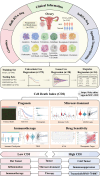


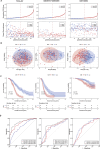


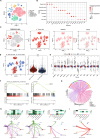
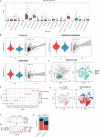
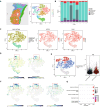



Similar articles
-
A novel defined programmed cell death related gene signature for predicting the prognosis of serous ovarian cancer.J Ovarian Res. 2024 Apr 29;17(1):92. doi: 10.1186/s13048-024-01419-y. J Ovarian Res. 2024. PMID: 38685095 Free PMC article.
-
Characterization of prognostic signature related with twelve types of programmed cell death in lung squamous cell carcinoma.J Cardiothorac Surg. 2024 Oct 1;19(1):569. doi: 10.1186/s13019-024-03039-5. J Cardiothorac Surg. 2024. PMID: 39354528 Free PMC article.
-
Prognostic Cell Death Index for Lung Adenocarcinoma: A Comprehensive Transcriptome-Based Analysis of Twelve Programmed Cell Death Pattern Genes.Front Biosci (Landmark Ed). 2024 Apr 1;29(4):135. doi: 10.31083/j.fbl2904135. Front Biosci (Landmark Ed). 2024. PMID: 38682187
-
Multi-omics in high-grade serous ovarian cancer: Biomarkers from genome to the immunome.Am J Reprod Immunol. 2018 Aug;80(2):e12975. doi: 10.1111/aji.12975. Epub 2018 May 21. Am J Reprod Immunol. 2018. PMID: 29781548 Review.
-
Gene Signatures and Oncology Treatment Implications.Hematol Oncol Clin North Am. 2025 Apr;39(2):295-307. doi: 10.1016/j.hoc.2024.11.003. Epub 2024 Dec 17. Hematol Oncol Clin North Am. 2025. PMID: 39694780 Review.
Cited by
-
Discovery of Dynamic Models for AML Disease Progression from Longitudinal Multi-Modal Clinical Data Using Explainable Machine Learning.medRxiv [Preprint]. 2025 Apr 15:2025.04.07.25325267. doi: 10.1101/2025.04.07.25325267. medRxiv. 2025. PMID: 40297459 Free PMC article. Preprint.
-
Multi-omics perspectives for gastrointestinal malignancy: A systematic review.World J Gastrointest Surg. 2025 Jul 27;17(7):107110. doi: 10.4240/wjgs.v17.i7.107110. World J Gastrointest Surg. 2025. PMID: 40740914 Free PMC article.
References
-
- Awasthi N, et al. BMS-754807, a small-molecule inhibitor of insulin-like growth factor-1 receptor/insulin receptor, enhances gemcitabine response in pancreatic cancer. Mol Cancer Ther. 2012;11(12):2644–53. - PubMed
-
- Brogden RN, Wiseman LR, Topotecan. A review of its potential in advanced ovarian cancer. Drugs. 1998;56(4):709–23. - PubMed
MeSH terms
Substances
Grants and funding
LinkOut - more resources
Full Text Sources
Medical

